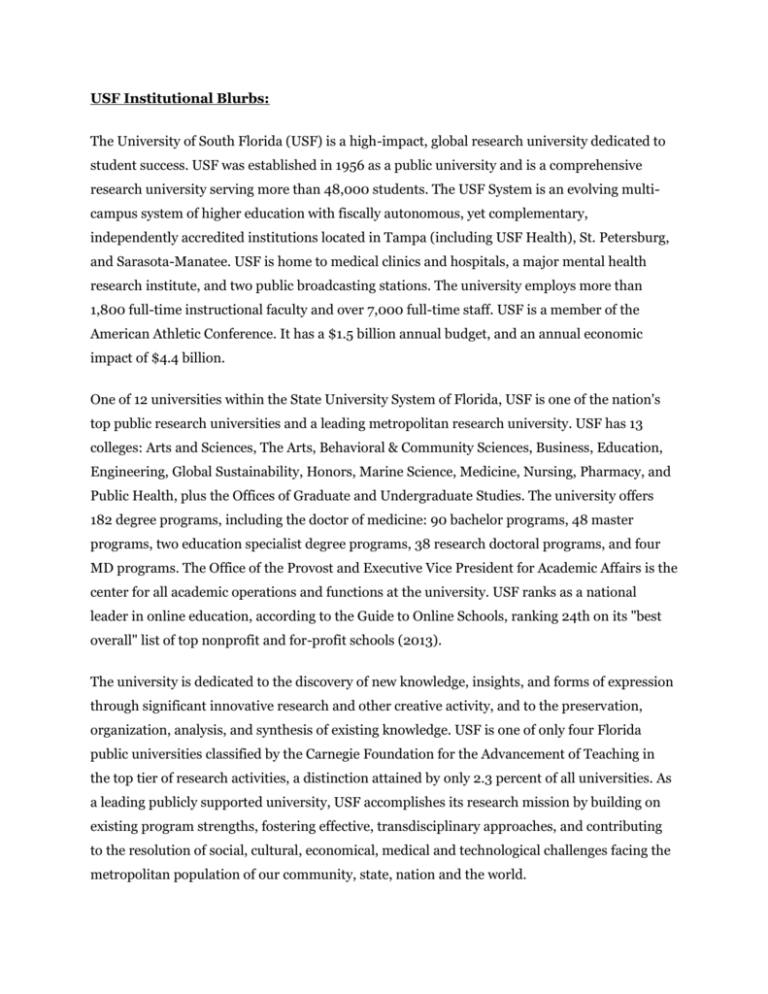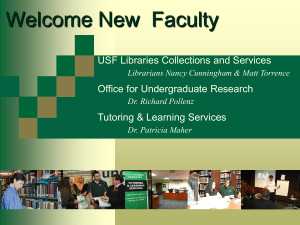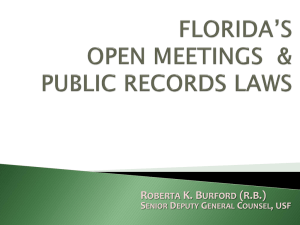Facilities & Institutional Blurbs - Biology
advertisement

USF Institutional Blurbs: The University of South Florida (USF) is a high-impact, global research university dedicated to student success. USF was established in 1956 as a public university and is a comprehensive research university serving more than 48,000 students. The USF System is an evolving multicampus system of higher education with fiscally autonomous, yet complementary, independently accredited institutions located in Tampa (including USF Health), St. Petersburg, and Sarasota-Manatee. USF is home to medical clinics and hospitals, a major mental health research institute, and two public broadcasting stations. The university employs more than 1,800 full-time instructional faculty and over 7,000 full-time staff. USF is a member of the American Athletic Conference. It has a $1.5 billion annual budget, and an annual economic impact of $4.4 billion. One of 12 universities within the State University System of Florida, USF is one of the nation's top public research universities and a leading metropolitan research university. USF has 13 colleges: Arts and Sciences, The Arts, Behavioral & Community Sciences, Business, Education, Engineering, Global Sustainability, Honors, Marine Science, Medicine, Nursing, Pharmacy, and Public Health, plus the Offices of Graduate and Undergraduate Studies. The university offers 182 degree programs, including the doctor of medicine: 90 bachelor programs, 48 master programs, two education specialist degree programs, 38 research doctoral programs, and four MD programs. The Office of the Provost and Executive Vice President for Academic Affairs is the center for all academic operations and functions at the university. USF ranks as a national leader in online education, according to the Guide to Online Schools, ranking 24th on its "best overall" list of top nonprofit and for-profit schools (2013). The university is dedicated to the discovery of new knowledge, insights, and forms of expression through significant innovative research and other creative activity, and to the preservation, organization, analysis, and synthesis of existing knowledge. USF is one of only four Florida public universities classified by the Carnegie Foundation for the Advancement of Teaching in the top tier of research activities, a distinction attained by only 2.3 percent of all universities. As a leading publicly supported university, USF accomplishes its research mission by building on existing program strengths, fostering effective, transdisciplinary approaches, and contributing to the resolution of social, cultural, economical, medical and technological challenges facing the metropolitan population of our community, state, nation and the world. USF faculty, students and staff are proactive in the search for new knowledge and consistently demonstrate their concern about the world in which we live. With the support of private and public agencies, they contribute to our knowledge about the world and apply their findings and skills to solving many of the problems facing contemporary society. Many contributions evolve from basic research; others, from practical applications of new knowledge. Other projects make specialized training available to public officials, organizations working for social betterment, religious and educational institutions, and business and manufacturing organizations. Through sponsored and non-sponsored activities, USF faculty, students and staff make significant contributions to instructional programs. The dedication of USF researchers, students and staff has contributed to the phenomenal growth in research that USF experienced over the past 30 years. In FY1986, the university received only $22.3 million in external funding for research projects. By the end of FY1995, research awards had reached over $100 million. In FY2014, USF generated over $428 million in sponsored research. The Chronicle of Higher Education's Almanac of Higher Education ranked USF as the nation's fifth growing research university from 2000-2010. The University of South Florida is one of only 40 public research universities nationwide with very high research activity (RU/VH) that is designated as "community engaged" by the Carnegie Foundation for the Advancement of Teaching. According to the National Science Foundation, USF ranks 43rd in the nation for total research expenditures among all U.S. universities, public or private, and 27th in total research expenditures for public universities (2013). USF ranks 12th worldwide among all universities granted U.S. patents (2013), ranking in the top 15 for four years in a row (2010-2013), according to the Intellectual Property Owners Association. The university supports economic development and the translation of USF research and technologies to the marketplace, through an active Technology Transfer Office and USF CONNECT, the economic development arm of USF. The Tampa Bay Technology Incubator, with nearly 60 resident and affiliate companies, is part of UCF CONNECT, which is located in the USF Research Park, named Emerging Research Park of the Year in 2008 by the Association of University Research Parks. USF has numerous research and health care partnerships through affiliation agreements with hospitals and not-for-profit organizations in the metropolitan Tampa Bay area. USF affiliates include the H. Lee Moffitt Cancer Center and Research Institute, James A. Haley Veterans Hospital, C.W. Bill Young Department of Veterans Affairs Medical Center (formerly Bay Pines VA Hospital), Tampa General Hospital, All Children's Hospital, Bayfront Medical Center, Shriner's Children's Hospital, Florida Hospital Tampa, and the U.S. Geological Survey. As a National Cancer Institute Comprehensive Cancer Center, the Moffitt Cancer Center, located on the USF Tampa campus, is part of an elite group of cancer centers nationwide that focus on the quick translation of research advances to improvements in patient care and has developed a strong national reputation for excellence. The James A. Haley Veterans Hospital, located within walking distance of USF Health's Morsani College of Medicine, provides research and training experiences for faculty, staff, and students. The USF Health System is also closely affiliated with Tampa General Hospital and the Lakeland Regional Medical Center, which provide training for residents and medical students. The Shriner's Children's Hospital (at USF Tampa), Florida Hospital Tampa (within walking distance), All Children's Hospital, Bayfront Medical Center and the C.W. Bill Young Department of Veterans Affairs Medical Center (in St. Petersburg), as well as the USF Health Byrd Alzheimer's Institute (at USF Tampa), provide additional research and training grounds for USF faculty and students. Affiliate partnerships established with Mote Marine Laboratory and the Charles Stark Draper Laboratory have expanded the research and development capacities, student educational opportunities, and economic development impact of USF. Affiliation agreements with organizations normally provide for collaboration through shared facilities, faculty, and equipment, as well as support for graduate students and internship programs. These types of agreements enable the institutions to pool resources, such as laboratory space, and enable compliance committees to stimulate an exchange of ideas. Throughout the university's development, the faculty at USF have identified and satisfied needs on a local, national and global scale. A variety of activities in such areas as health care, neuroscience, transportation, informatics, cybersecurity, education and engineering are conducted by specialized research and development centers and institutes. The university currently has over 100 such centers and institutes, many of which function in an interdisciplinary fashion, enabling coordination of projects across colleges. From developing sources of clean energy, to enhancing the quality of life for people with disabilities and leading the way on veterans' research and reintegration, USF research, innovation and economic development is focused on creating local, national and global solutions to society's most difficult problems. Various Facilities/Other Resources at USF: CMMB Core Facility: Resources include Microarray, Flow Cytometry, Tissue Culture, Microscopy, Multiplex Systems, Cryogenic Repository, etc. Please see website for full details: http://biology.usf.edu/cmmb/research/facility.aspx CDDI: Cell Biology Core: Cell isolation and analysis (combined College of Medicine/CDDI core). The cell biology core provides researchers access to cell sorting and analysis for target characterization and validation. The BD FACS Aria II sorter is BSL2 capable permitting levels of safety in cell sorting not available in most flow cores. A second BD Canto II flow cytometer provides automated sampling for analytical flow cytometry. Fully automated Zeiss Axiovert 100 deconvolution and Lecia DM 6000 (laser microcapture) microscopes provide tools for protein analysis with particle resolution >0.5mm. CDDI core laboratories are equipped with the following instrumentation: Cell isolation and analysis (combined COM/CDDI core). BD-FACSaria II cell sorter (BSL2 capable) and BD Canto II analytical flow cytometers. Zeiss Axiovert 100 deconvolution and Lecia DM 6000 laser capture fluorescent microscopes. ABI 7900 real time PCR and Agilent model 2100 bioanalyzer. Chemodiversity Facility: The Chemodiversity facility offers libraries of natural product-derived crude extracts, fractions and pure compounds for screening as well as medicinal chemistry and hit-tolead synthetic capabilities. Small molecules high resolution mass measurement, quantification and metabolomics (GC/MS QToF), mass targeted chromatographic separation (LC/MS SQ) and screening for anthelmintic, antimicrobial, permeability and drug solubility evaluation are provided. The services also include general chromatography (MPLC, HPLC) and spectroscopic characterization (UV, IR) as well as microbiology workspace (biosafety cabinets), training and synthesis activities. The CDDI Chemodiversity facility is equipped with the following instrumentation: Teledyne-Isco MPLC (UV) and Shimadzu HPLC (UV, RID) systems TECAN Freedom EVO 150 liquid handling automated workstation Tecan Infinite/ M-1000 multimode plate reader Heidolph control valve rotary evaporators, Savant SC210A speedvacuum concentrators Labconco 4.5 Liters freeze dryer and SP Scientific general purpose 35 Liters freeze dryer Agilent 7890 GC/ 7200 MS QToF Agilent preparative 1200 LC/ 6120B MS SQ Anton-Paar monowave reactor 300 for assisted microwave synthesis Agilent Cary FTIR 630 spectrometer and Cary 60 UV/Vis spectrophotometer Labconco synthetic fume hoods and Thermo scientific biosafety hoods Innovative Technologies Pure Solv Micro solvent purification system for anhydrous solvent preparation High Field NMR Facility The Center for Drug Discovery and Innovation offers state-of-the-art ultra-high field NMR instrumentation for the structural studies, especially in metabolomics, and biomacromolecular structural biology, etc. NMR core laboratory enables researchers to characterize protein structure at atomic resolution. The facility includes NMR spectrometers operating at 14 and 18 Tesla with associated HCN triple resonance cold probes that have carbon-enhanced and salt tolerant capabilities, which supply the highest possible 1H and 13C sensitivity for all applications. Technical support and training are available for all aspects of project development including feasibility studies as well as advanced protein-ligand interaction studies. The resources of the NMR facility can be accessed either on a fee-for-service basis or on collaborative projects. The fee-based services include acquisition and analysis of the required spectra for structure elucidation of small molecules (e.g. synthetic molecules, natural products, and small peptides etc.). The collaborative projects include NMR solution structure determinations of biomacromolecules, protein dynamic studies, RDCs measurements, protein-protein (or with various ligands) interactions (Drug screening). Please contact us for more detailed information on NMR experiments conducting and collaborations. CDDI core laboratories are equipped with the following instrumentation: Agilent VNMRS 600 and 800 MHz spectrometers with cold probes Protein Production Core Protein production is a significant bottleneck in early phase drug discovery. Two laboratories serve this mission housed in CDDI and COM under the direction of a core director. The production laboratories are fully equipped and staffed to help the researcher produce proteins in bacteria, yeast or insect cells. Whether the protein is hopelessly insoluble or difficult to produce in quantity the core staff is ready to work with individuals to turn failure into success. Expression Vector Construction We have stocks of expression vectors with different combinations of fusion tags, including polyhistidine-tag (6xHis), Glutathione S-transferase (GST), Maltose-binding protein (MBP), Nus A, and solubility-enhancement tag (SET). We can also use customer-supplied vectors. Protein Expression Recombinant proteins would be expressed in bacteria (E. coli), yeast and baculovirus (insect cells) systems. Small-scale trials would be used to find the best condition and cell line for expression and solubility level. Large-scale expression can be performed in New Brunswick BioFlo 310 fermentor (1-14 liter) or temperature-controlled shaking incubators. Solubility Optimization A solubility screening system has been set up to search the best lysis buffer combination for difficult projects. Our latest trial showed about 26% increase in solubility of a target protein. Protein Purification The core is equipped with multiple GE AKAT systems and a Bio-Rad Duo Flow system. We provide protein purification using affinity (6xHis, GST, etc), ion-exchange, and/or size exclusion chromatography, from a few to several hundred milligrams protein. The target could be from either natural or recombinant sources. Protein Characterization The core is equipped with a state-of-the-art nano crystallization robot that can screen thousands of conditions in a matter of hours. It is capable of dispensing without contact a nanoliter quantity of sample both accurately and reproducibly. We have regular synchrotron X-ray access and the ability to perform remote data collection of macromolecule X-ray diffraction. We provide regular protein characterization services including SDS-PAGE, western blot and quantitation of purified protein using NanoDrop. The core is also equipped with a Bio-Rad Plex 200 (Luminex) XMap Technology system and a Q-Sense E4 Quartz Crystal Microbalance - with dissipation monitoring (QCM-D). Major Equipment GE AKTA Explorer (housed in COM) GE AKTA Purifier Pre-packed Ni-affinity, GST-affinity, Ion-exchange and Size Exclusion Chromatography columns Bio-Rad BioLogic Duo Flow FPLC system NBS BioFlow 310 Fermentor with 2.5 and 14 liter capacity Temperature-controlled Shaking Incubators ARI Crystal Phoenix Liquid Handling System (housed in COM) Insect cell culture facilities (housed in COM) Sorvall RC6 highspeed centrifuge with 4x1000 capacity French Press and Misonic 4000 sonicator Proteomics and Mass Spectrometry Core The Proteomics and Mass Spectrometry Facility provides expertise in biological mass spectrometry for large-scale protein identification and characterization as well as quantitative proteomics-based workflows. The facility is equipped with highperformance mass spectrometers with electrospray ionization sources coupled to nanoflow liquid chromatographs - ideal for proteomics applications. Services include accurate mass analysis of intact proteins and small molecules, one-dimensional separation (e.g. ion-exchange chromatography, SDS-PAGE, Gel-FREE), isotope labeling for multiplex relative and absolute quantitation of proteins from normal, disease, and drug-treated states, posttranslational modification enrichment and characterization, and label-free relative quantitation of cell and tissue extracts. We provide on-site training to undergraduate/graduate students and post-doctoral scholars. CDDI laboratories are equipped with the following instrumentation: Hybrid linear ion trap-Orbitrap (LTQ Orbitrap XL, Thermo) nLC/MS High-throughput Proteomics Platform Accurate Mass Measurement (< 5 ppm) Relative Quantitation (SILAC) Posttranslational Modifications Recombinant Protein Molecular Weight Large Scale Proteomic Experiments Linear ion trap (LTQ XL, Thermo) nLC/MS High-throughput Proteomics Platform Gel-Band Protein Identification Spectral Counting Relative Quantitation Project Development Samples MSn Analysis of Small Molecules Triple quadrupole (TSQ Quantum Ultra, Thermo) nLC or LC/MS High-throughput Targeted MS Experiments Targeted nLC Quantitation of Diagnostic Proteins/Peptides High-Throughput Targeted MS Experiments Targeted quantitation of small molecules Project Development Samples New in 2014 Hybrid Quadrupole-Orbitrap (Q Exactive Plus, Thermo) nUPLC/MS High-throughput Proteomics/Metabolomics Platform Extended Mass Range (m/z 50-600) Improved resolving power to 140,000 at m/z 200 Improved Sensitivity and Scan Rate up to 12 Hz Multiplexing up to 10 precursors per scan (iTRAQ) Mass Accuracy to < 3 ppm Polarity Switching for Single Acquisition Metabolomics Profiling UPLC for improved peak resolution and higher throughput Protein Informatics Software MASCOT - Bioworks - MaxQuant - Scaffold 4.3.4 - Ingenuity Pathway Analysis Moffitt: Resources include Analytic Microscopy, Biostatistics, Cancer Informatics, Cell Therapies, Chemical Biology, Flow Cytometry, Image Response Assessment Team, Molecular Genomics, Proteomics, Small Animal Imaging Lab, Survey Methods, Tissue Culture, and Translational Research. Please see website for full details: http://moffitt.org/careers/research-careers/cores




